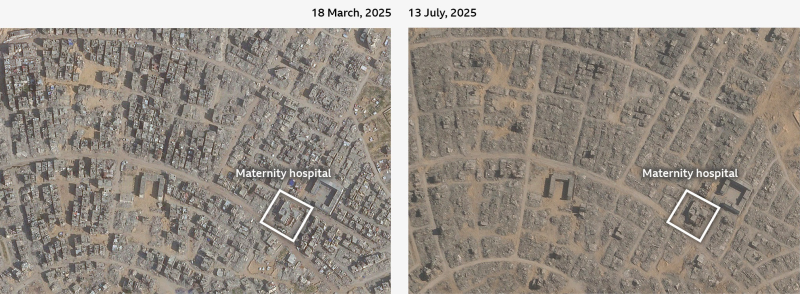- Security Council Divided on United States' Venezuela Action |
- Over 1.53m voters register for postal balloting: Shafiqul Alam |
- Bangladesh Bank to liquidate 9 NBFIs in financial sector reforms |
- Govt Moves to Clear Tk20,000cr Dues to Avoid Summer Outages |
- Maduro Pleads Not Guilty in US Court, Claims Presidency |
Israel Demolishing Thousands of Gaza Civilian Buildings

Rafah’s only maternity hospital stands as one of the few buildings still intact amid widespread demolitions across the city in recent weeks.
Israel has demolished thousands of buildings across Gaza since ending a ceasefire with Hamas in March, with entire towns and neighbourhoods—once home to tens of thousands—reduced to rubble in recent weeks.
Much of the destruction stems from planned demolitions of both damaged and largely intact structures. Some of the cleared areas are reportedly intended for potential Israeli settlements and what critics describe as “camps” for Palestinians unwilling to evacuate.
The Israeli Defense Forces (IDF) stated that demolitions target buildings where Hamas allegedly conceals military assets. They insist that property destruction is carried out only when deemed a military necessity. However, Israel has not provided specific justifications for many documented demolitions.
Satellite imagery reveals widespread destruction in areas under Israeli control. Verified footage shows controlled demolitions levelling tower blocks, schools, and civilian infrastructure, with dust and debris filling the air after large explosions.
Legal experts suggest Israel’s actions may constitute war crimes under the Geneva Convention, which restricts an occupying power from destroying civilian infrastructure.
In July, Israeli Defence Minister Israel Katz announced plans to build a "humanitarian city" on the ruins of Rafah, intending to confine 600,000 Palestinians there. The proposal has drawn sharp criticism, including from former Israeli Prime Minister Ehud Olmert, who warned it could be perceived as creating a “concentration camp.”
Rafah’s Tel al-Sultan neighbourhood has suffered extensive demolitions. Once home to Rafah’s only maternity hospital and an orphan care centre, much of the area has now been flattened. Only a few buildings, including the hospital, remain.
Nearby areas such as the Saudi neighbourhood, once home to Rafah’s largest mosque and several schools, are undergoing similar destruction.
Demolitions are also occurring in towns that had previously escaped extensive bombardment. In Khuza’a, a farming town near the Israeli border, the IDF has demolished 1,200 buildings, labelling them as parts of Hamas’ “terror infrastructures.”
A similar pattern is evident in Abasan al-Kabira, a town of 27,000 people before the conflict, where satellite images show vast areas cleared within just over a month.
In Qizan Abu Rashwan, virtually all structures have been destroyed since mid-May. Verified video footage shows controlled explosions levelling entire clusters of buildings.
Human rights lawyers argue that the destruction violates international law. Eitan Diamond of the Diakonia International Humanitarian Law Centre said such demolitions are prohibited except in cases of absolute military necessity.
“Destroying property based on possible future use falls far outside legal exceptions,” Diamond noted.
Professor Janina Dill of Oxford University added that occupying powers are required to manage territories for the benefit of local populations. She said Israel’s actions render the area uninhabitable, which is “incompatible with international law.”

